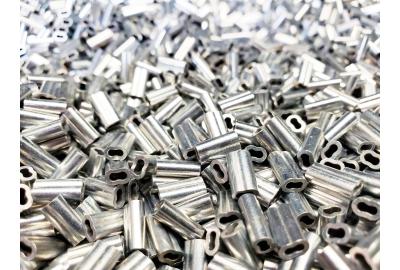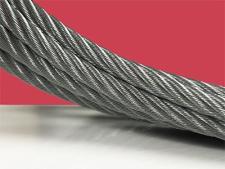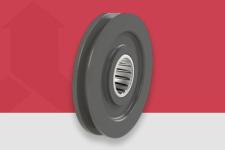Cable loop sleeves are among the most common mechanical cable components used in the termination of wire rope assemblies. A loop sleeve is a solid oval or figure-8-shaped fitting that is swaged around the cable and most commonly used to form either a loop at the end. In smaller diameter cables, loop sleeves may be used as a stop sleeve. Using a powerful machine known as a press, sufficient pressure is applied to the loop sleeve, crimping down onto the base of the wire rope, which from there, enables the user to install the loop end cable into the larger product or mechanical device.
Copper, aluminum and stainless steel are the most commonly used metals to produce loop sleeves. Custom materials are available upon request. Copper and aluminum loop sleeves are made from extruded bar, whereas stainless alternatives are made from flattened tubing. Loop sleeves are available in a wide variety of sizes.
Understanding what loop end cable to choose can be the difference between extending or shortening the life of your mechanical cable and devices. As each application has unique demands, one should examine thoroughly their requirements before selecting the wire rope ferrule best suited to the product.
Specifications of Loop Sleeves
Loop sleeves are generally available in stainless steel, brass, aluminum and bare, tin or zinc-plated copper. At Carl Stahl Sava Industries, we offer loop sleeves that are available in many sizes and follow specification guidelines for one of the following:
-
Commercial Generic Sizes, and
-
MIL-Spec or MS51844 - These are loop sleeves manufactured per military specifications and are commonly used when a set of governing standards must be honored.
Common Usages
As discussed, the most common purpose of a loop sleeve is to form a loop on the end of mechanical cable. Since there are many reasons one would require a loop in their wire rope assembly, loop sleeves serve a variety of functions from keyring holders to eyelets, or from safety tethering to terminating at the base of a device. Given the ubiquitous reasons to loop mechanical cable, it isn’t difficult to understand why loop sleeves are seen across virtually any industry, including fragile medical devices, robotics, exoskeletons as well as load bearing applications like anchoring, lifting, swinging and so on.
Copper and Aluminum Loop Sleeve
Both copper and aluminum are inherently soft materials. Loop sleeves made out of copper and aluminum are generally figure 8-shaped when examined cross-sectionally. This is because, as discussed, they are manufactured using an extrusion process in which the metal is pushed through a figure-8-shaped die to form the loop sleeve. This feature can be found in both copper and aluminum sleeves.
There are many advantages when using copper or aluminum loop sleeves. For example, both metals are relatively inexpensive and can each be easily swaged. However, because copper and aluminum are soft metals, when they are cut they produce a burr on the cut edge that must be smoothed out. These are inexpensive fittings, but still retain the full integrity being swaged. For this reason, while the burr may be cosmetically concerning, the cost-effectiveness makes the burr a forgivable condition.
What’s more, aluminum loop sleeves sometimes do not provide the consistent tensile strength that copper provides. They are known to produce fluctuating results during tension tests and thus, where undeviating tensile performance is a high priority, aluminum may need to be substituted for a different material.
Stainless Steel Loop Sleeves
Stainless steel loop sleeves can be manufactured per commercial or MIL-Spec standards. These sleeves will hold the full-rated strength of the cable being swaged and also offers the additional benefits of corrosion-resistance inherent in stainless steel.
Stainless steel loop sleeves are usually made out of tubing that have been flattened to a specific size to fit two cables side-by-side through the sleeve. The sleeve is then pressed down to hold the full cable strength. Stainless steel loop sleeves have uniform radii, thus making them suitable for use in precision industries. Unlike copper and aluminum, cut stainless steel loop sleeves do not produce any burr around the cut edge. An area of concern one might have with stainless steel loop sleeves is that they cannot be swaged by hand. Instead, one has to use larger tools for this purpose. For this reason, it is prudent to have stainless steel loop sleeves swaged through the manufacturer.
Key Takeaways
Choosing the loop sleeve suited to your application is a complicated exercise. Getting this done incorrectly and you may shorten the lifespan of the mechanical cable or worse, the entire mechanical device, instrument or machine. To ensure you get your loop sleeve selection process right every time, here are a few key takeaways to making the right choice:
-
Loop sleeves are made of different materials and come in a variety of sizes.
-
Copper and aluminum loop sleeves are easy to form using hand-held tools.
-
Stainless steel loop sleeves are more durable and generally cannot be swaged by hand.
-
Loop sleeves have a variety of uses in different industries, making it imperative that one carefully select the right fitting for each job.
At Carl Stahl Sava Industries, we offer a complete line of world-class loop sleeves that suit most small and medium mechanical cable applications. Contact us today to learn more about our offerings and how we can help you with your requirements.






